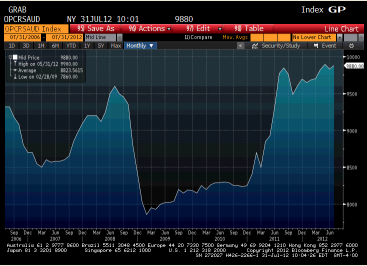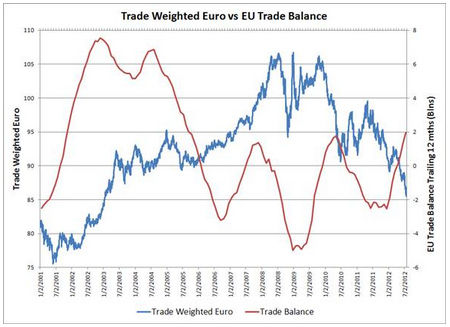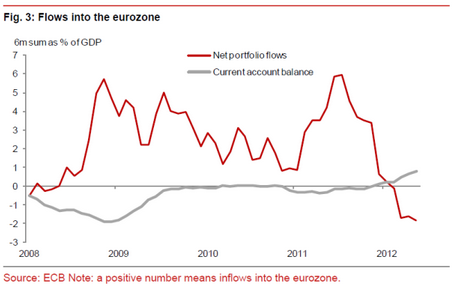Not that it matters, of course, but all’s that’s needed is for the Fed to guarantee that all US obligations mature at 100. The Fed is fully authorized to buy US tsy securities and can certainly buy them at maturity value on their maturity date, simply by crediting the appropriate accounts. And the ratings agencies fully recognize that authority.
ECB’s Hansson Says Germany Can Be Outvoted on Governing Council
Karim writes:
This is correct. The Bundesbank voting no is technically equivalent to Lacker dissenting at every FOMC meeting this year. It would be a bigger statement if dissents came from the Executive Board (the equivalent of Yellen dissenting vs a regional Fed bank president).
ECB’s Hansson Says Germany Can Be Outvoted on Governing Council
By Ott Ummelas
August 3 (Bloomberg) — European Central Bank policy maker Ardo Hansson, who heads Estonia’s central bank, said Germany c be outvoted on the ECB’s Governing Council.
“There are 23 members in the council and if there will be a vote then everyone’s vote has the same weight in the sense that some questions are solved by a majority,” Hansson told Eesti Rahvusringhaaling radio today when asked if new ECB bond purchases can be approved without German support.
While there was unanimity on the council to investigate options in the coming month, “there could be differing views of details and these would need to be solved in negotiations,” Hansson said. He also said purchases will focus on “relatively short-term debt instruments.”
ECB August Meeting
Not to forget this is the just the beginning of ‘doing what it takes’ to sustain the euro, and make it ‘safe’ for investors.
That’s all inclusive, though not necessarily immediate.
And ‘anchoring’ the short end ‘automatically’ goes a very long way towards anchoring the long end with regard to risk premium.
Karim writes:
Draghi announced significant philosophical changes today. The key announcements were:
- The ECB was ready to renounce seniority on its bond purchases.
- The size of future purchases was open-ended: ‘size adequate to reach its objectives’.
- Future purchases may not be sterilized, as they have been with the SMP so far.
- Purchases would be front-end focused as that ‘falls squarely in line with monetary policy instruments’. A key instrument is obviously the LTROs. So would imagine purchases would be 3yrs and in on the curve.
The adherence of governments to their commitments and the fulfilment by the EFSF/ESM of their role are necessary conditions [for some action on the ECB side]. The Governing Council, within its mandate to maintain price stability over the medium term and in observance of its independence in determining monetary policy, may undertake outright open market operations of a size adequate to reach its objective. In this context, the concerns of private investors about seniority will be addressed.
Other news was that:
- As in the excerpt above, purchases would be subject to strict conditionality via the EFSF (i.e., Spain has to accept a Memorandum of Understanding). Fiscal consolidation and structural reform were listed as the key conditions.
- He threw cold water on the ESM getting a banking license, saying he was ‘surprised by the attention this has received’.
- Logistics and objectives on bond purchases were TBD by a committee.
- Further non-standard measures were forthcoming.
- Rate cuts were discussed but unanimously voted down; as for a negative depo rate he said ‘we are in unchartered waters’, implying the hurdle may be high.
Relative to levels before Draghi’s London speech last week, Spanish 2y yields are 200bps lower, and 10yr yields are 50bps lower.
Quick update
A few more modest ‘green shoots’ including US personal income up .5, a few more jobs, houses and cars looking reasonable firm, etc. and markets starting to ‘undiscount’ a US recession.
Govt deficits remain plenty high to support income/sales/employment at current (depressed) levels and promote modest growth. Just as in the prior two double dip panics of the last several years, markets and the mainstream tend to give little if any weight to the notion that large deficits support aggregate demand. (Interesting how ideology seems to be adversely influencing their forecasting.)
So right now I see no fundamental reason for a meaningful drop in aggregate demand, apart from a politically driven external shock of some sort from Europe or maybe Iran, where there have been a few too many very recent noises regarding an Israeli attack for comfort.
Swiss Manufacturing Slump Unexpectedly Eases on Output Gain
By Simone Meier and Klaus Wille
August 2 (Bloomberg) — Swiss manufacturing contracted at a slower pace in July than in the previous month as companies stepped up production, suggesting that the economy is weathering Europe’s deepening slump.
The procure.ch Purchasing Managers’ Index rose to 48.6 from 48.1 in June, when adjusted for seasonal swings, Credit Suisse Group AG said in an e-mailed statement today. That’s the highest since March. A reading below 50 indicates contraction.
Marginal rise in construction output, but new orders continue to decline during July
August 2 (Markit) — At 50.9 in July, up from 48.2, the Markit/CIPS Construction PMI rebounded slightly from June’s two-and-a-half year low. However, the latest reading was well below the long-run series average (54.2). Growth was largely confined to the commercial sub-sector in July, as house building and civil engineering activity continued to decline. July data indicated a further reduction in new work received by construction companies. Although the rate of decline eased over the month, it was still the second-fastest since January 2010. Survey respondents widely cited a lack of new opportunities to tender and a general weakness in underlying market demand.
Sweden Krona Jumps as Rate Cut Calls Fade on Accelerating Growth
By Stephen Treloar and Johan Carlstrom
August 1 (Bloomberg) — Sweden’s krona surged, posting the biggest gains of all major currencies, after a report showed manufacturing unexpectedly expanded, damping speculation the Riksbank will cut interest rates at its meeting next month.
The krona rose as much as 0.8 percent to 8.2979 per euro, the highest since Sept. 11, 2000, and was up 0.5 percent at 8.3217 as of 1:15 p.m. in Stockholm. It surged almost 0.9 percent against the dollar to 6.7411, a three-month high. It gained against all 16 major currencies tracked by Bloomberg.
An index based on responses from purchasing managers rose to a seasonally adjusted 50.6 in July from 48.4 the previous month, Stockholm-based Swedbank AB said today. A reading above 50 signals an expansion. It was estimated to drop to 47.7, according to the median estimate in a Bloomberg survey.
“Following the surprisingly strong GDP number Monday this gives further ammunition for unchanged Riksbank rates at the September meeting and lends additional support to krona appreciation,” said Claes Maahlen, head of trading strategy at Svenska Handelsbanken AB in Stockholm, in a note today.
Sweden has been able to avoid a recession this year as companies such as retailer Hennes & Mauritz AB and Sandvik AB have benefitted from demand outside Europe and as the central bank cut interest rates. The economy expanded 1.4 percent in the second quarter as increased exports of services offset a decline in the export of goods. Consumer spending also rose.
The yield on Sweden’s two-year notes increased three basis points to 0.9 percent.
Treasury Plans Floating Rate Notes, Looks at Negative
It’s getting to be downright embarrassing to be an American…
Treasury Plans Floating Rate Notes, Looks at Negative Rate Bids
By Meera Louis and Cheyenne Hopkins
August 1 (Bloomberg) — The U.S. Treasury Department said today it is developing a floating rate note program that could be operational at least a year away, while it is also looking at capabilities for negative rate bidding.
The U.S. Treasury Department said it plans to sell $72 billion in notes and bonds in next week’s refunding. The Treasury intends to auction $32 billion in 3-year notes on Aug. 7, $24 billion in 10-year notes on Aug. 8 and $16 billion in 30-year bonds on Aug. 9.
“Treasury plans to develop a floating rate note program to complement the existing suite of securities issued and to support our broader debt management objectives,” the department said in a statement today. “The first FRN auction is estimated to be at least one year away.”
The Treasury also said it is “in the process of building the operational capabilities to allow for negative rate bidding in Treasury bill auctions, should we make the determination to allow such bidding in the future.”
The Treasury said that the U.S. debt limit is expected to be reached at the end of this year, and it expects to use “extraordinary measures” to fund the government into early 2013.
The Obama administration said July 27 it is forecasting the federal budget deficit will be $1.21 trillion this year, down from $1.33 trillion projected in February. The U.S. faces a so- called fiscal cliff of higher taxes and reductions in spending on defense and other government programs that will take effect at year-end unless Congress acts.
“I think it’s pretty clear that the Treasury has to tread lightly,” William O’Donnell, head U.S. government bond strategist at the Stamford, Connecticut-based RBS Securities primary dealer unit of Royal Bank of Scotland Group Plc., said by e-mail before the report. “There is a lot of uncertainty in the near-future path(s) of outlays and receipts and the fog may not lift until the fiscal issues are addressed.”
ECB notes?
An interesting move by the ECB would be to offer short to medium term notes in the market place.
As discussed over the years, unlike other currencies, the euro has no ‘risk free deposits’ available to anyone other than member banks and foreign governments.
This has probably caused substantial numbers of investors to sell their euro for other currencies rather than hold any of the available euro denominated financial assets.
If so, ECB notes could mark the return of these portfolio to ‘normal’ allocations to euro denominated financial assets, which would offer strong support for the euro vs other currencies.
And with the ECB measuring success by the strength of the euro, this could be an attractive proposition.
It would attract euro deposits from the banking system, which the ECB can easily accommodate by continuing its current policy of liquidity provision for its member banks as needed.
Additionally, and not that it actually matters for inflation, lending, aggregate demand, etc., most monetarists would not include these notes as part of the ‘money supply’ but instead as an anti inflationary ‘sterilization’ measure.
Interest income loss from rate cuts
Word’s getting around, from CS:
The side-effect of the Fed’s near-zero interest medicine – the collapse in personal interest income over the last few years. The decline in interest income actually dwarfs estimates of debt service savings. Exhibit 2 compares the evolution of household debt service costs and personal interest income. Both aggregates peaked around $1.4 trn at roughly the same time – the middle of 2008. According to our analysis of Federal Reserve figures, total debt service – which includes mortgage and consumer servicing costs – is down $206bn from the peak. The contraction in interest income amounts to roughly $407bn from its peak, more than double the windfall from lower debt service.
Saudi Crude Oil Production
Saudi production up a tad for July.
With the Saudis posting prices and letting their clients buy all they want at the posted prices, this shows marginal global net demand has yet to fall off, and, in fact increased a bit.
And, if Saudi excess capacity isn’t as high as the 12.5 million bpd reported a relatively small supply disruption could result in an immediate spike in price.

More from the 1996 conference
Trade Weighted Euro vs EU Trade Balance
Interesting dynamics at work. Trade can drive the currency and/or the currency can drive trade.
Looks to me like early on it was the trade that was driving up the currency, But more recently the currency looks to be driving trade.
That is, portfolio managers have been shifting out of euro due to the crisis, cheapening it to the point where the trade flows are on the other side of their portfolio shifting.
For example, someone selling his euro for dollars is effectively selling them to an American tourist buying tacos in Spain. Euros shift from the portfolio manager to the Spanish exporter.
Trade flows are generally large, price driven ships to turn around, and continuous as well. Portfolio shifts, while they can also be large, are more often ‘one time’ events, driven by fear/psychology, as has likely been the case with the euro. So a turn in psychology that ‘rebalances’ portfolios to more ‘normal’ ratios can be very euro friendly.

>
> (email exchange)
>
> This was an interesting chart from Nomura that came out over the weekend discussing
> the current account against the portfolio flows – suggests that the portfolio flows
> have turned significantly negative for Europe and are much bigger than the positive
> effects of the current account.
>
Yes, agreed. this says much the same story I was telling, only better!

